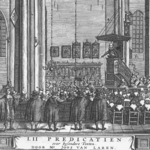Religieuze co-existentie en de publieke kerk. Walcheren en Staats-Vlaanderen, 1602-1630
DOI:
https://doi.org/10.18352/bmgn-lchr.7378Keywords:
ToleranceAbstract
Religious Co-Existence and the Public Church: Walcheren and Flanders of the States, 1602-1630
During the past decades, the study of religious tolerance has shifted from its earlier focus on philosophical and legislative sources to a focus on daily practice, making use of detailed case studies. This article partly traces this historiographical shift by focusing on a locality in Zeeland. Although the Dutch Republic was renowned for its tolerance, Zeeland somehow was neglected in the historiography on religious tolerance. Whereas many studies have neglected the role of ecclesiastical organizations – or assumed that they played only a negative role in the space for religious co-existence – this article argues that these organizations in fact played a crucial role. For this reason, I have chosen to investigate the ‘classis Walcheren’ (the ecclesiastical assembly responsible for the region Walcheren and the Flanders of the States) during the first thirty years of the seventeenth century. This institution, which brought together all the reformed preachers of the region, had a strong influence on the churches, but also on society as a whole. Asking what exactly the ambitions and function of the classis and the reformed churches were, allows their impact on religious co-existence to be understood.
Downloads

Downloads
Published
Issue
Section
License
Authors who publish with this journal agree to the following terms:
a) Authors retain copyright and grant the journal right of first publication with the work simultaneously licensed under a Creative Commons Attribution 4.0 International (CC BY 4.0) that allows others to share the work with an acknowledgement of the work's authorship and initial publication in this journal.
b) Authors are able to enter into separate, additional contractual arrangements for the non-exclusive distribution of the journal's published version of the work (e.g., post it to an institutional repository or publish it in a book), with an acknowledgement of its initial publication in this journal.
c) Authors are permitted to post their work online (e.g., in institutional repositories or on their website) prior to and during the submission process.
Authors are explicitly encouraged to deposit their published article in their institutional repository.











